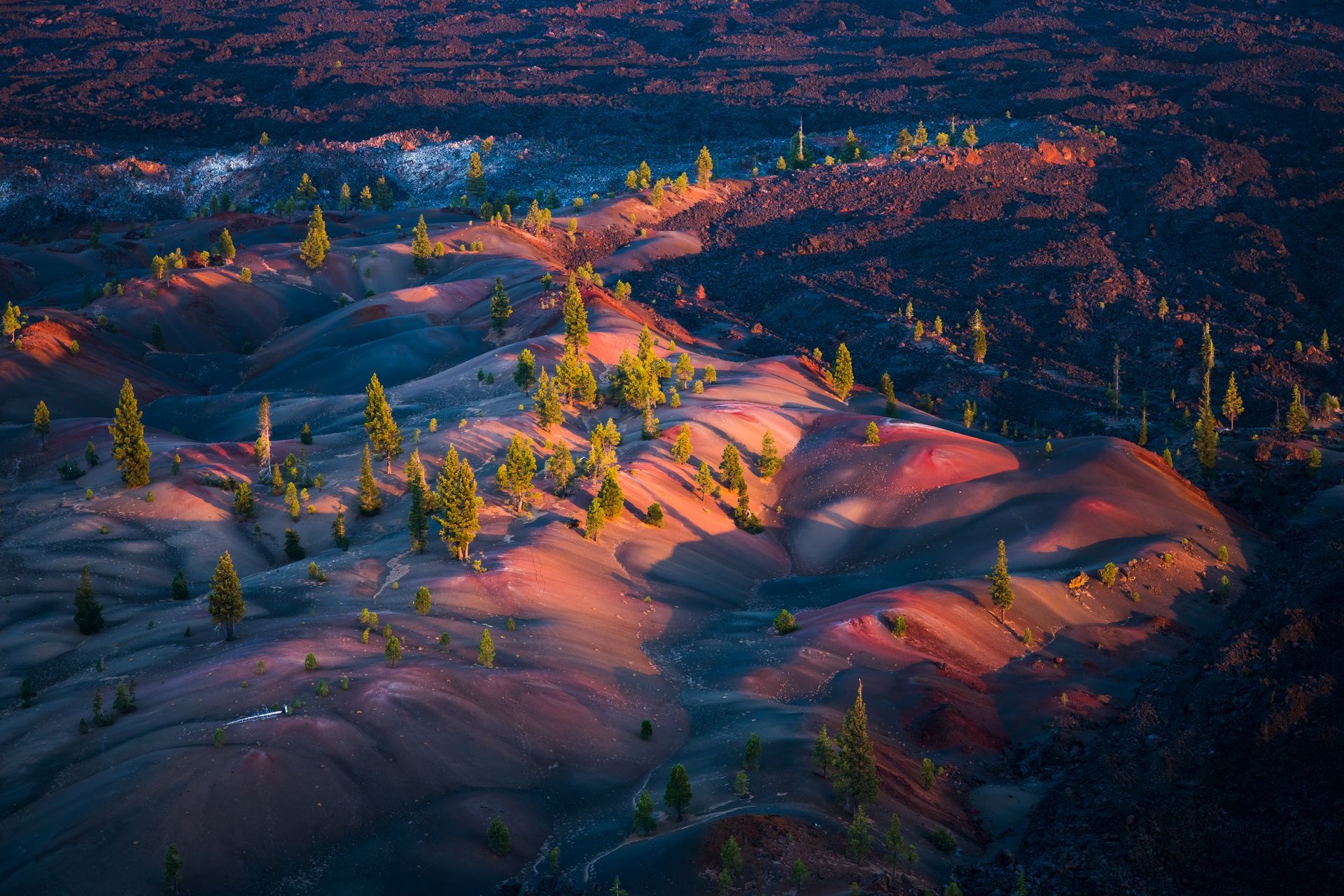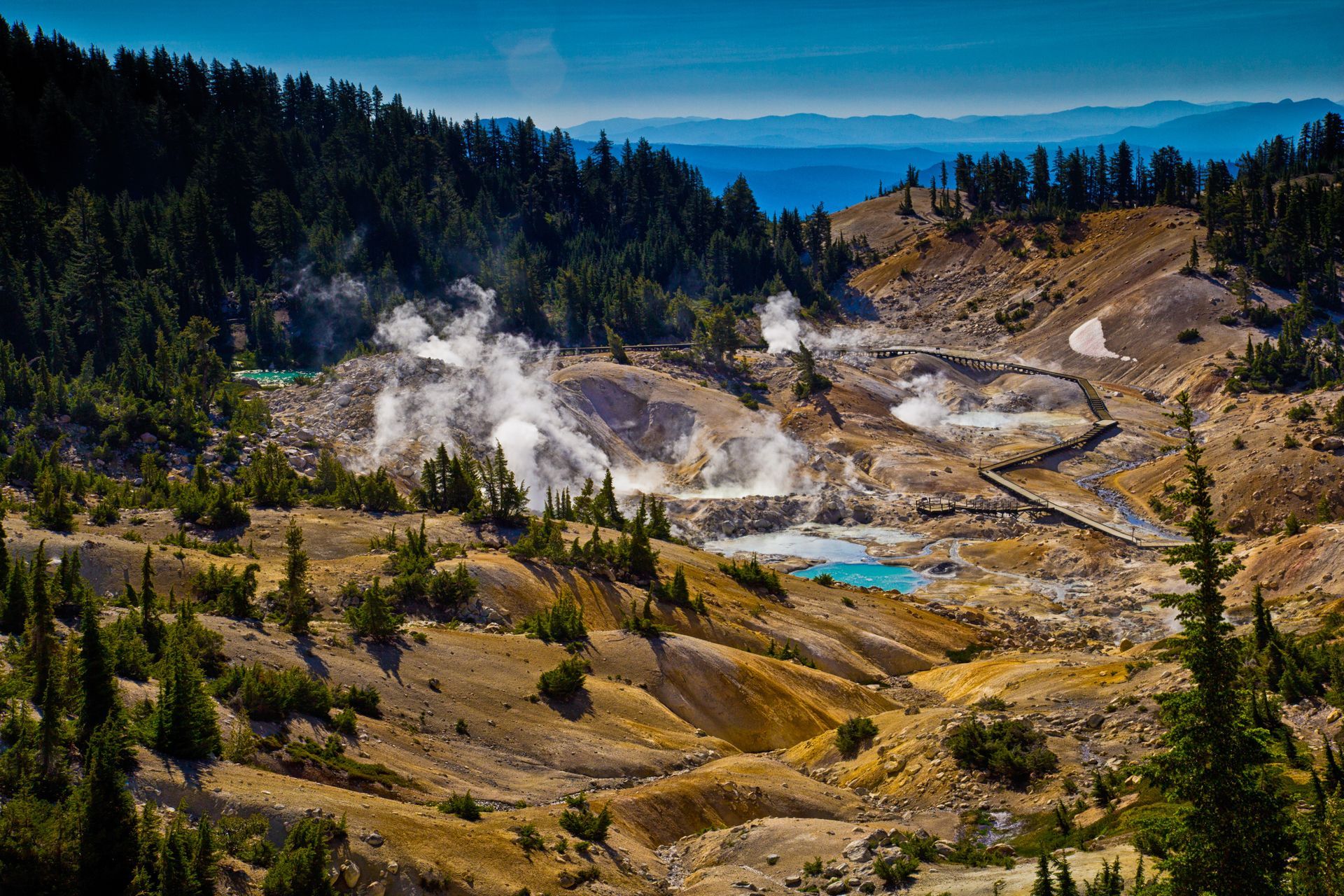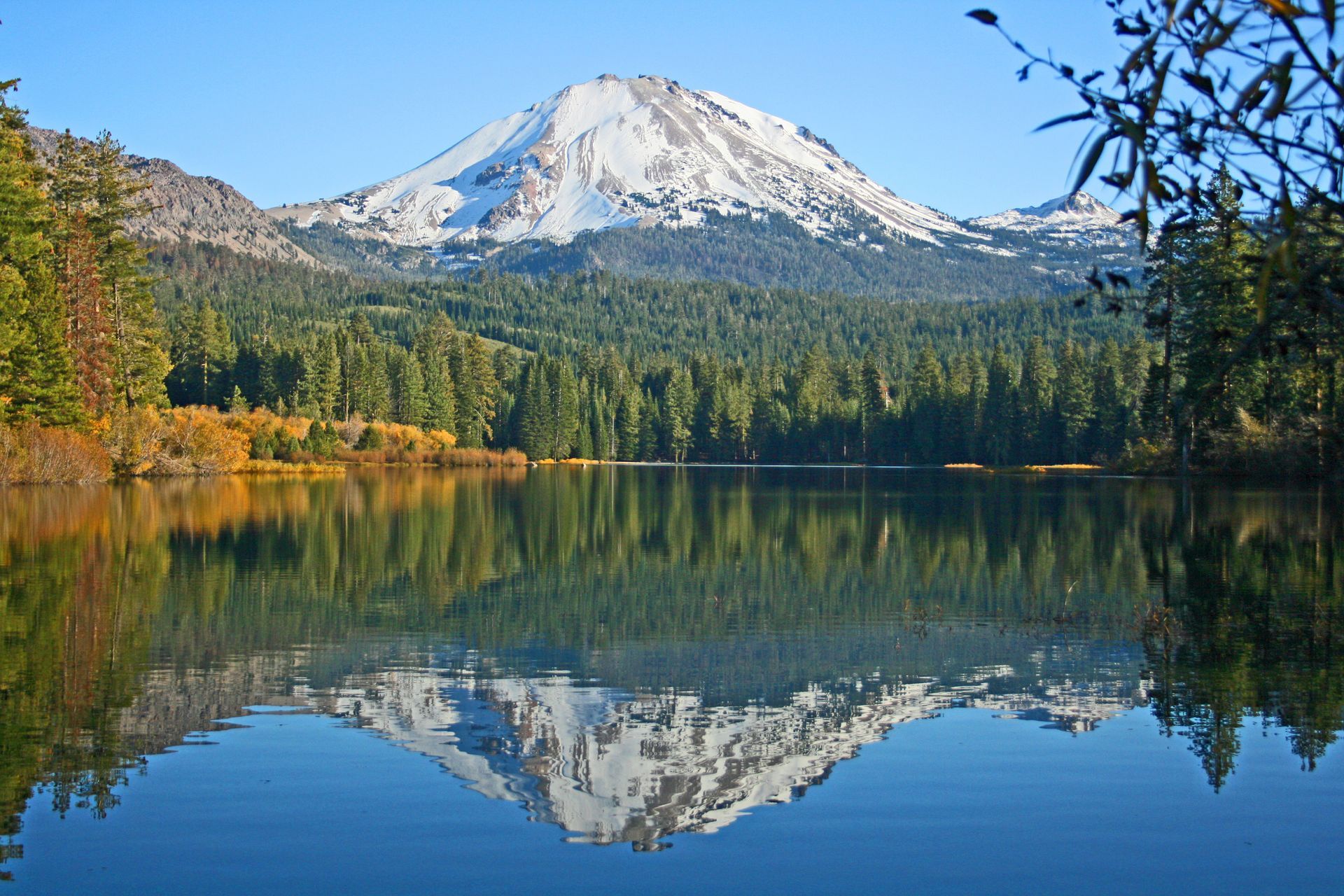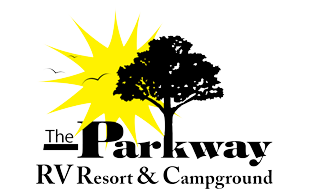
Your Ultimate Guide to Lassen Volcanic National Park
Who is this guide for?
- First-time visitors, families, hikers, and RV travelers seeking a friendly, practical guide to Lassen Volcanic National Park.
Quick links:
- What Is Lassen Volcanic National Park?
- Things to Do at the Park
- Best Time of Year to Visit
- Travel Tips (Read These Before You Go)
- Frequently Asked Questions
- Stay at The Parkway RV Resort and Campground
Looking for a getaway that’s a little different? How about steaming natural vents, sapphire lakes, and summit views without shoulder-to-shoulder crowds? That’s Lassen Volcanic National Park for you, and there’s enough going on here to warrant a spot at the top of your travel list.
This guide to Lassen Volcanic National Park covers what the park is, the best things to do, when to go, practical travel tips, and answers to common questions—plus a spotlight on a comfortable basecamp nearby.

What Is Lassen Volcanic National Park?
Tucked into Northern California’s southern Cascades, Lassen Volcanic National Park features four major volcano types in one compact park: shield, composite, cinder cone, and plug-dome (the park’s namesake, Lassen Peak, is a plug-dome). The result? A landscape that feels part Yellowstone (bubbling mud pots and hissing fumaroles) and part high Sierra (granite peaks, alpine meadows, and sparkling tarns), all stitched together by a scenic road that crests around 8,000 feet.
Beyond the science story, Lassen is beloved because it’s manageable. You can hit signature sights in a day, or slow down over a long weekend and add a peak, a waterfall, and a sunset at the Painted Dunes. For families, photographers, and first-time visitors, this guide will help you plan the kind of trip that balances big “wow” moments with easy logistics.
Things to Do at the Park
Bumpass Hell Boardwalk
The park’s largest hydrothermal basin is a must-see. A well-graded trail leads to boardwalks where vents, mud pots, and neon pools dot the landscape. Go early or late for softer light and fewer people, and stay on the boardwalks to avoid any missteps.
Lassen Peak Summit
Five miles round-trip is a decent hike, but the views are worth it. Take it slow, enjoy the sweeping views of the southern Cascades, and bring layers to shield yourself from strong winds near the top. On a clear day you’ll see Mt. Shasta looming to the northwest.
Manzanita Lake
A calm, reflective lake framed by pines and that postcard Lassen Peak backdrop. Walk the flat lakeshore loop, rent a kayak or SUP in summer, or settle in for sunset photography. Great for families and a slower pace.
Kings Creek Falls
A classic waterfall hike through meadows that explode with wildflowers in summer. Many sections are rocky, so make sure to wear sturdy shoes. Pack a light picnic and linger at the viewpoint to really take it all in
Cinder Cone & the Painted Dunes (Butte Lake area)
One of the West’s most surreal short hikes: a steep cinder path up a black cone, then 360° views over the Fantastic Lava Beds and rust-red Painted Dunes. Aim for sunrise or late afternoon when the colors glow.
Sulphur Works
A roadside taste of hydrothermal action, perfect if your crew is short on time or energy. Steam vents and boiling mud sit just steps from the parking area, making this one of the easiest stops in the whole park.
Winter Snow Play & Snowshoeing
When the road closes to through-traffic, there’s still plenty to do in this snowy wonderland. Snowshoe to peaceful meadows, try cross-country skiing, or join ranger-led walks when available. It’s an underrated season with big rewards.
Stargazing & Night Photography
High elevation, minimal light pollution, and clear summer nights make Lassen a gem for Milky Way chasers. Manzanita Lake and the Devastated Area are popular night spots, so bring a blanket, a telescope, or just gaze up at the endless expanse of stars.
Wildlife & Wildflowers
Look for deer browsing at dawn, Clark’s nutcrackers chattering in the whitebark pines, and meadows painted with lupine and mule’s ears in July. Keep your distance and use binoculars rather than approaching animals.

Best Time of Year to Visit
- Summer to early fall (July–September) is prime time. Most trails are snow-free, the full road is open, and services are at their peak. Expect warm afternoons, cool nights, and the chance of smoke during regional fire season.
- Late spring/early summer (May–June) can be a shoulder season with lingering snowbanks, especially on higher trails. The upside: waterfalls roar, crowds are thinner, and wildflowers begin to pop at lower elevations.
- Fall (late September–October) brings crisp air, golden meadows, and quieter trails. Some facilities downshift to shoulder hours, and early storms are possible, so carry layers and check conditions.
- Winter (roughly November–April) brings
deep snow. Swap hiking boots for snowshoes and enjoy a park that’s quiet, sparkling, and serene. If you’re flexible and well prepared, it’s magic.
Travel Tips (Read These Before You Go)
- Acclimate to altitude. Much of Lassen sits between 6,000 and 8,500 feet, with Lassen Peak topping 10,000+. Even fit hikers feel the elevation. Hydrate, pace yourself, and plan shorter hikes on arrival day.
- Dress in layers. Mountain weather flips fast. A sun hoodie, insulating mid-layer, windproof shell, hat, and gloves cover most scenarios, even in summer mornings or summits.
- Protect yourself from the sun. High-elevation UV is no joke. Sunscreen, sunglasses, and a brimmed hat will make the day much more pleasant.
- Mind hydrothermal safety. Stay on boardwalks and signed trails; the ground can be thin with scalding water beneath. Keep children close and never test water temperatures.
- Pets have limits. Dogs are welcome in developed areas like campgrounds and parking lots, but not on park trails or in the backcountry. Plan kennel days or trade off hikes within your group.
- Cell service is spotty. Download maps, trail info, and offline directions. A paper map is handy if your phone dies.
- Driving & road conditions. The park highway is mountain driving, which means curves, grades, and occasional construction. Studded tires or chains are good to have in shoulder seasons when storms threaten.
- Leave No Trace. Stay on stable surfaces, pack out all trash, and give wildlife lots of space. Hydrothermal crusts are fragile; even a few steps off trail can
cause lasting damage.
Frequently Asked Questions
Is the park open year-round?
Yes, but access changes with seasons. In winter the main road usually closes to through-traffic and both ends of the park function as snow gateways. Summer brings full access to most areas, but always check current conditions before you go.
How hard is the Lassen Peak hike?
It’s a stout 5-mile round-trip with significant elevation gain at altitude. Most people can do it with time, water, and breaks, but expect a steady climb and cooler, windier conditions near the top.
What are the can’t-miss stops for a first visit?
Bumpass Hell, Manzanita Lake, Sulphur Works, and (if you’re up for it) Lassen Peak. Add Kings Creek Falls if you have half a day, or Cinder Cone and the Painted Dunes if you can devote a full half-day to the Butte Lake side.
Are there family-friendly activities?
Absolutely. Manzanita Lake’s flat loop, the Devastated Area interpretive trail, and roadside stops like Sulphur Works are great for young kids. In winter, sledding hills near the visitor areas are popular.
Is Lassen good in winter?
Yes, if you like snow! It’s a great place for beginner-friendly snowshoeing and quiet winter landscapes. Dress warmly and check avalanche and weather advisories if you go beyond developed areas.
Can I bring my dog on trails?
No. Dogs are not permitted on park trails or in the backcountry. They’re welcome on roads, in parking areas, and in campgrounds when leashed (6 ft max).

Stay at The Parkway RV Resort and Campground
If you’re rolling in an RV or just want a comfortable base with room to breathe, consider The Parkway RV Resort and Campground as your launchpad. Located along the I-5 corridor in the Northern California Shasta Cascade region, we make a convenient staging point for day trips to the park and other attractions.
Why it works as a basecamp:
- Comfortable sites. Expect spacious, level RV sites (including pull-through options) with the full-hookup conveniences road-trippers love. Many spots offer shade, which is important during the long summer afternoons.
- Easy amenities. Typical comforts include restrooms and showers, laundry, Wi-Fi, and a seasonal pool—handy for cooling off after a hot day on the cinders.
Pet-friendly & family-friendly. Bring the dog, set up the camp chairs, and unwind between adventures. - Day-trip range to Lassen. You can relax in a quiet setting at night, then head into the park for a full day of hiking and exploring. We’re also well placed for side trips to Lake Almanor, Burney Falls, and the Subway Cave lava tube.
How to use The Parkway in your itinerary:
- Day 1: Arrive and settle in, then enjoy a sunset stroll and dinner at your site.
- Day 2 (Lassen classics): Drive the park highway, walk the boardwalk at Bumpass Hell, stop at Sulphur Works, and linger at Manzanita Lake for golden-hour reflections.
- Day 3 (pick your adventure): Summit Lassen Peak if conditions and energy allow, or head to Kings Creek Falls for a more relaxed hike. Photographers should plan an afternoon at Cinder Cone for Painted Dunes color before returning to camp.
Whether you’re after a quiet, well-kept RV spot or just want an effortless home base between national park days, The Parkway RV Resort and Campground offers the kind of convenience and comfort that lets you focus on the fun.
Final Planning Notes
We hope this guide has helped you to plan your ideal Lassen Volcanic National Park vacation. For the latest road status, trail conditions, and any seasonal restrictions, check official channels before you roll. Then pack layers, plenty of water, a wide-brim hat, and your sense of adventure. With striking geology, approachable trails, and a comfortable place to stay, you’re set for an unforgettable trip.
